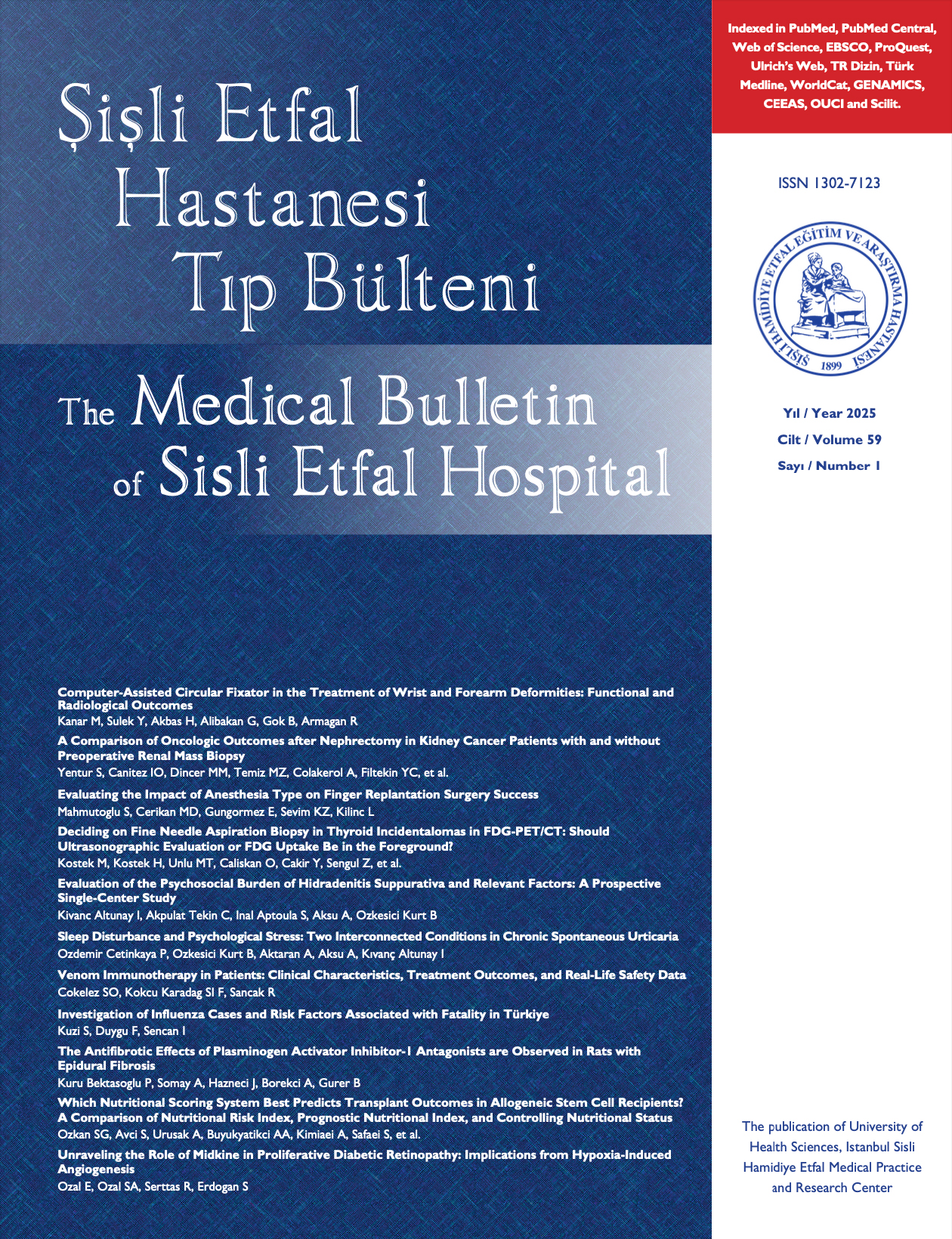
Akut Komplike Olmayan Divertikülit Tedavisi: Yatarak veya Ayaktan
Emre Teke1, Huseyin Ciyiltepe2, Nuriye Esen Bulut1, Yasin Gunes1, Mehmet Mahir Fersahoglu1, Anil Ergin1, Bora Karip3, Kemal Memisoglu11SBÜ Fatih Sultan Mehmet Eğitim ve Araştırma Hastanesi, Genel Cerrahi Kliniği, İstanbul2Antalya Eğitim ve Araştırma Hastanesi, Gastroenteroloji Cerrahi Kliniği, Antalya
3İstanbul Onkoloji Hastanesi, Genel Cerrahi, İstanbul
Amaç: Divertiküler hastalık oldukça sık görülen bir durumdur. Batı toplumunda dokuzuncu dekatta nüfusun %50'sini etkiler. Akut divertikülit en sık görülen komplikasyondur. Klinik olarak stabil olup sıvıyı tolere eden hastalar, sıvı alım toleransı kötüleşirse, ateş yükselirse veya ağrı artarsa hastaneye yatırılmalıdır. Bağırsak istirahati, intravenöz sıvı tedavisi ve ampirik antibiyotik tedavisi, hastaneye başvuran hastalarda geleneksel tedavilerdir. Bu retrospektif çalışma, komplike olmayan akut divertikülit tanısı alan hastaların ayaktan veya yatarak tedavisini etkileyecek parametreleri belirlemeyi amaçlamaktadır.
Yöntemler: Ocak 2018-Aralık 2020 tarihleri arasında karın ağrısı ile acil servise başvuran ve intravönöz contrast madde verilmesi sonrası çekilen bilgisayarlı tomografide(BT) komplike olmayan divertikülit (modifiye Hinchey 1a) tanısı alan hastalar çalışmaya dahil edildi. Hasta kayıtları retrospektif olarak Excel dosyasına kaydedildi. Acil serviste görüldükten sonra yatan hasta grubu (Grup 1) ile ayaktan takip grubu (Grup 2) arasında karşılaştırma yapıldı.
Bulgular: Çalışma akut komplike olmayan divertiküliti (modifiye Hinchey 1a) olan 172 hastayı içermektedir. 110 (%64,0) hasta yatarak takip ve tedavi edilirken (Grup 1) 62 (%36,0) hasta ayaktan (Grup 2) takip edildi. Taburculuk sonrası ilk 30 gün içinde (hem ayaktan takip edilen hem de yatan hasta grubunda tedavi sonrası) hastaneye tekrar başvuran hastalar açısından iki grup arasında istatistiksel olarak anlamlı fark yoktu.
Sonuç: Komplike olmayan Modifiye Hinchey 1a hastalarında yatış kriterlerini değerlendirdiğimiz bu retrospektif çalışmada hastaların şiddetli fizik muayene bulguları olmaması durumunda güvenle ayaktan tedavi olabileği bulundu. Taburculuk sonrası yeniden hastaneye yatış açısından iki grup arasında fark olmamasına ve Modifiye Hinchey 1a divertiküliti olan hastaların ayaktan oral antibiyotik tedavisi ile takibinin güvenilir olabileceği düşünülse de, daha geniş hasta sayısı ile prospektif çalışmalara ihtiyaç vardır. (SETB-2022-02-030)
Management of Acute Uncomplicated Diverticulitis: Inpatient or Outpatient
Emre Teke1, Huseyin Ciyiltepe2, Nuriye Esen Bulut1, Yasin Gunes1, Mehmet Mahir Fersahoglu1, Anil Ergin1, Bora Karip3, Kemal Memisoglu11Department of General Surgery, University of Health Sciences Türkiye, Fatih Sultan Mehmet Training and Research Hospital, Istanbul, Türkiye2Department of Gastroenterology Surgery, Antalya Training and Research Hospital, Antalya, Türkiye
3Department of General Surgery, Istanbul Oncology Hospital, Istanbul, Türkiye
Objectives: Diverticular disease is a highly frequent condition and affects 50% of the population in the 9th decade in Western society. Acute diverticulitis is the most prevalent complication. The patients who are clinically stable and tolerate fluid should be hospitalized if fluid intake tolerance worsens, fever occurs, or pain increases. Bowel rest, intravenous fluid therapy, and empiric antibiotic therapy are the traditional treatments for patients admitted to the hospital. This retrospective study aimed to determine the parameters that will affect the outpatient or inpatient treatment of patients diagnosed with uncomplicated acute diverticulitis.
Methods: Patients who presented to the emergency department with abdominal pain between January 2018 and December 2020 and were diagnosed with uncomplicated diverticulitis (modified Hinchey 1a) on computed tomography (CT) taken after intravenous contrast material shoot up were included in the study. Patient records were recorded retrospectively in the Excel file. After being seen in the emergency department, a comparison was performed between the inpatient group (Group 1) and the outpatient follow-up group (Group 2).
Results: The study comprised 172 patients with acute uncomplicated diverticulitis (modified Hinchey 1a). While 110 (64.0%) patients were followed up and treated as inpatients (Group 1), 62 (36.0%) patients were followed up as outpatients (Group 2). There was no statistically significant difference between the two groups in terms of patients readmitted to the hospital in the first 30 days after discharge (both for outpatient follow-up in the emergency department and after treatment in the inpatient group).
Conclusion: In this retrospective study, in which we evaluated the hospitalization criteria in uncomplicated Modified Hinchey 1a patients, it was found that patients can be safely treated as an outpatient if they have poor physical examination findings. Although there was no difference between the two groups in terms of hospital readmission after discharge and it was thought that follow-up of patients with Modified Hinchey 1a diverticulitis with outpatient oral antibiotic therapy might be reliable, prospective studies with larger numbers of patients are needed.
Makale Dili: İngilizce



















